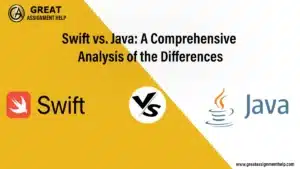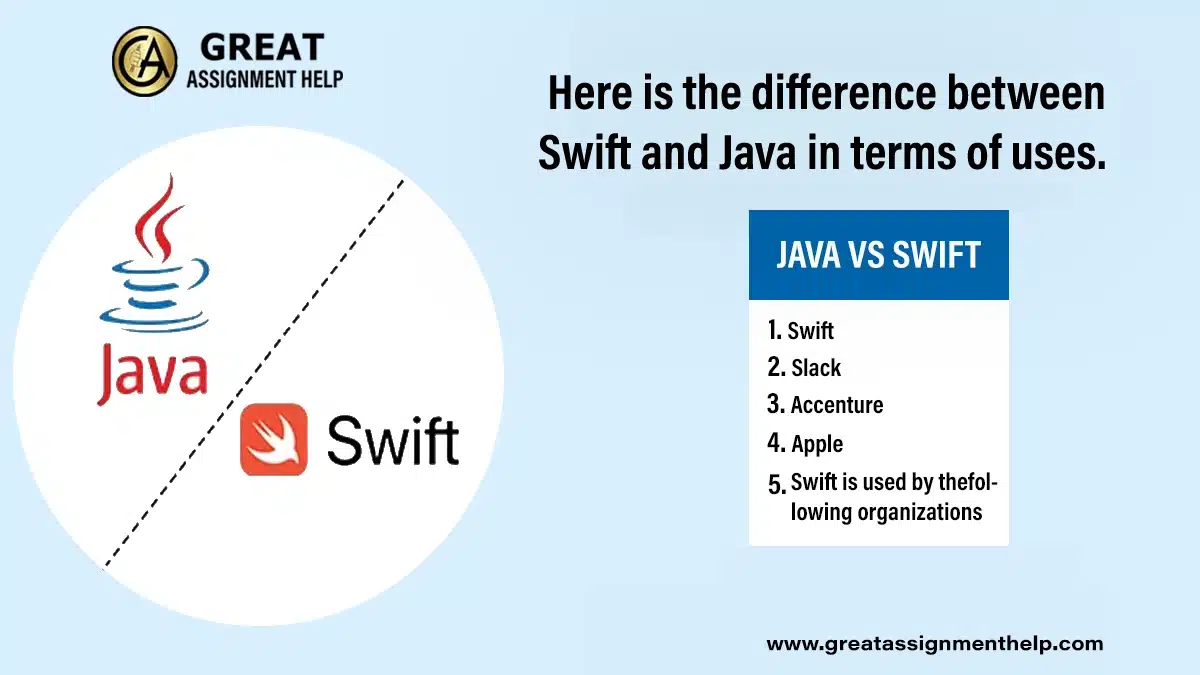Students pursuing a degree in programming find Swift and Java imperative. However, there is a difference in their functionalities, operations, and many other areas. For example, Java is used to develop application software while Swift creates the Apple environment. Java uses complete keywords to develop its syntax while Swift uses partial phrases. If you are intrigued to learn the differences between Swift vs. Java, then read this blog. Here, we have analyzed the complete distinction between the two programming languages.
But before moving to the comparison of Java vs. Swift, first, let us have a look at a brief overview of Swift and Java.

What is Swift?
Swift is a multi-purpose programming language created on June 2, 2014. It is a modern, commanding, creator-friendly, open-source programming language built with an open LLVM compiler. Apple Inc designed it to utilize Apple merchandise like iPads iOS tv, etc. However, it also supports many other devices. You can easily, code, compile, and run a program with it. For example, you can run codes used in objective programming languages like C, and C++ to run programs in this language. Apple developed Swift for creating Apple products like Apple cocoa and Cocoa touch frameworks.
History of Swift
Apple announced about launch of a new programming language called Swift at its worldwide developer conference on June 2, 2014. However, the collaboration with Chris Lattner and Doug Gregor John McCall to develop this language started in 2010. The company programmed this strong, uncomplicated-to-code, and open-source language by taking ideas from various other programming languages like Python, Ruby, and C.
Apple released Swift in its worldwide developer conference with Swift version 1.0 on September 9, 2014. After a year, the company upgraded the programming language with its Apache license, 2.0. The latest version is 5.8.1, released on June 1, 2023.
Features of Swift
The following are the unique features of Swift:
Wide Open-source community
Swift is an open-source programming language since it works on all platforms. Developers look for bug fixes and problems and share them with the community.
Easy to Code
Swift is very easy to write or read. Swift syntax is quick to learn and use. C, C++ language code also functions in a swift language.
Supports multiple devices
Swift is a programming language that works with many devices. It is mainly used in Apple products like mobile and desktop but it also supports many other devices.
Quick and strong
Swift is a contemporary, quick-functioning, and powerful language. In information technology, Swift programming language is high in demand. The primary reason behind it is the high performance and efficiency.
What is Java?
James Gosling developed a powerful, strong, widespread, class-based, and clean object-oriented and platform-independent programming language in 1995 called Java. Later, Oracle Database Company acquired Sun Microsystems’s program. This platform-independent programming quality helped Java to perform software or hardware systems. It is employed for developing multiple applications and gaming.
History of Java
James Gosling and Mike Sheridan Patrick Naughton, the father of Java programming language, started the program in June 1991 under the company Sun Microsystems. They initially named the program “Green Team”. After the launch of the program, the company used it primarily for programming set-top boxes, TVs, and other similar gadgets. Later, in 1994, Green Team was renamed Oak. Finally, on January 23, 1996, Java got its name and Java Development Kit was released with its first version Java1.0. The latest version of Java is Java 20. It was released on March 21, 2023.
Also read: Java Vs. Python: Which Of The Two Is Worth Learning?
Features of Java
Here are some exclusive characteristics of Java:
Simple
Java is a very straightforward language. However, it is more complicated to learn and comprehend in comparison to Swift. Java is an object-oriented language like C++. Moreover, its syntax is based on C++. However, it does not sustain pointers and operator overloading.
Platform independent
Programming languages like Java are platform-independent. It means Java can process both software and hardware systems. It includes Windows, Linux, Mac/OS, and other operating systems.
Distributed
Java is a distributed language. It means using enterprise Java beans and remote method invocation application program interface programmers can develop distributed applications. This feature allows programmers to access files through the internet from any machine.
Object-oriented programming
It is a pure Object Oriented Programming language. It means the software of Java is designed around data and objects instead of functions and logic. This feature helps programmers to contain data and behavior in their classes and objects.
Secure
Most programming languages have security as an additional feature. However, Java is the first language in computer programming that includes security an essential part of its design. Java compilers are developed with a security mind. The machines on which Java programming language is used are exceptional recognizers or identifiers. Additionally, the programming language focuses on data integrity to avoid accidental access to commoners.
Robust
Java is a powerful language. It employs mechanized garbage collection and exceptional handling.
Allocation
Java allocates memory in a stack. It has multiple advantages:
- Stack memory allows only the owner to access the memory.
- Allocation and deallocation become faster with stack memory
- Consumes less space
Multithreaded
Java has a multithreading feature. It can perform multiple tasks at the same time through a program.
Swift vs. Java: A Comparative Study
Here, let us look at how Swift differs from Java in various aspects.
Swift vs. Java: Speed
Swift and Java work at different speeds. Following are the distinctions between the speeds of the two programming languages.
- Swift: Swift’s overall performance is quite faster than that of Java. It processes Mandelbrot at 3.19 seconds while Java takes 6.83 seconds to perform.
- Java: Java is also a fast program. However, its speed is mostly restricted to mathematical and statistical functions. For example, Java processes binary trees in 8.32 seconds while Swift takes 45.06 seconds.
Read more: Best Java Project Ideas for Beginners and Experts
Swift vs. Java: Syntax
Swift and Java use different syntaxes to run a program. Here is the difference:
- Swift
Here is an example of the syntax of Swift:
/* My first program in Swift 4 */
var myString = “Hello, World!”
print(myString)
- Java
Following is an example of the Java syntax:
public class MyFirstJavaProgram {
/* This is my first Java program.
* This will print ‘Hello World’ as the output
*/
public static void main(String []args) {
System.out.println(“Hello World”); // prints Hello World
}
}
Swift vs. Java: Efficiency
Swift and Java are both highly efficient programming languages. However, when you compare them you will notice the following disparities:
- Swift: Working with Swift is all about prototyping and analyzing things. Therefore Swift executables are faster than that of Java.
- Java: On the whole, Java is less efficient compared to Swift. However, when it comes to taking action, Java is more efficient than Swift.
Swift vs. Java: Inheritance
Here is the difference between Swift and Java in terms of inheritance:
- Swift: Swift uses partial symbols. For example, class child parents.
- Java: During inheritance, Java uses complete keywords. For example, class child extends parents.
Swift vs. Java: Method Of Developing Objects
Swift and Java use different methods to develop objects. For example:
- Swift: It uses initializes, init (), that develop objects of specific class, function, or type. Hence they can also perform similar functions as constructors.
- Java: Java uses instructors to develop objects. The constructors in Java must be designated in the same class. For example, a demo contains a constructor as a demo ().
Swift vs. Java: Object Creation
- Swift: Object creation in Swift appears as Var obj: A=A
- Java: Object creation in Java appears as obj=new demo()
Swift vs. Java: Uses
Here is the difference between Swift and Java in terms of uses.

· Swift: Swift is used for developing iOS, macOS, and tvOS applications and games. In short, Swift develops the entire Apple ecosystem.
· Java: Java is used to develop application servers, web applications, android applications, desktop applications, enterprise applications, etc.
Swift vs. Java: Companies That Use It
Not all organizations that use Swift programming language use Java too. The companies that use Swift and Java are:
Swift
Swift is used by the following organizations
- Slack
- Accenture
- Apple
Java
The following companies use the Java programming language
- Uber
- Airbnb
- Netflix
- Spotify
- Amazon
- Snapchat
Also read: Get to Know the Difference between Java and JavaScript
Swift vs. Java: A Comparison Table
Check the table below to know the differences between Swift and Java.
| Basis Of Comparison | Java | Swift |
| Syntax | Java programming offers a more confusing and slightly complex syntax. | Swift syntaxes are easy to use, learn, and work with. |
| Inheritance | During inheritance, Java uses complete keywords. For example, class child extends parents. | Swift uses partial symbols. For example, class child parents |
| Method of developing objects | Java uses instructors to develop objects. The constructors in Java must be designated in the same class. For example, a demo contains a constructor as a demo (). | It uses initializes, init (), that develops objects of specific class, function, or type. Hence they can also perform similar functions as constructors. |
| Appearance of Object Creation | Object creation in Java appears as obj=new demo() | Object creation in Swift appears as Var obj: A=A |
| Community Support | Java offers vast community support to its users because it is an old programming language. | Swift has limited community support as it is a new programming language. |
| Readability | Java offers complex syntax and code readability. | Swift offers easy syntax and code readability. |
Similarities between Swift and Java
Swift and Java have many similarities. The most noticeable of them is that both languages are static. It indicates that they guarantee the safety of codes. In addition, both these languages are available in compiled format. It makes them fun faster than many other programming languages. Aside from that, both Swift and Java have a massive number of libraries. However, Java comes with a gigantic library as compared with Swift.
Conclusion
From the discussion above, it is clear that there are multiple differences between Swift and Java. The biggest distinctions are in the concept and syntax. Swift is open-source programming while Java is object-oriented programming. Moreover, Swift syntaxes are easy to learn and use. In contrast, the syntax used in Java is puzzling and complicated. If you are intrigued to learn more about these disparities or find it difficult to write assignments in any programming language, get in touch with quickly reach out to us. They can help you create error-free codes for your computer science assignments and get the desired grades.


